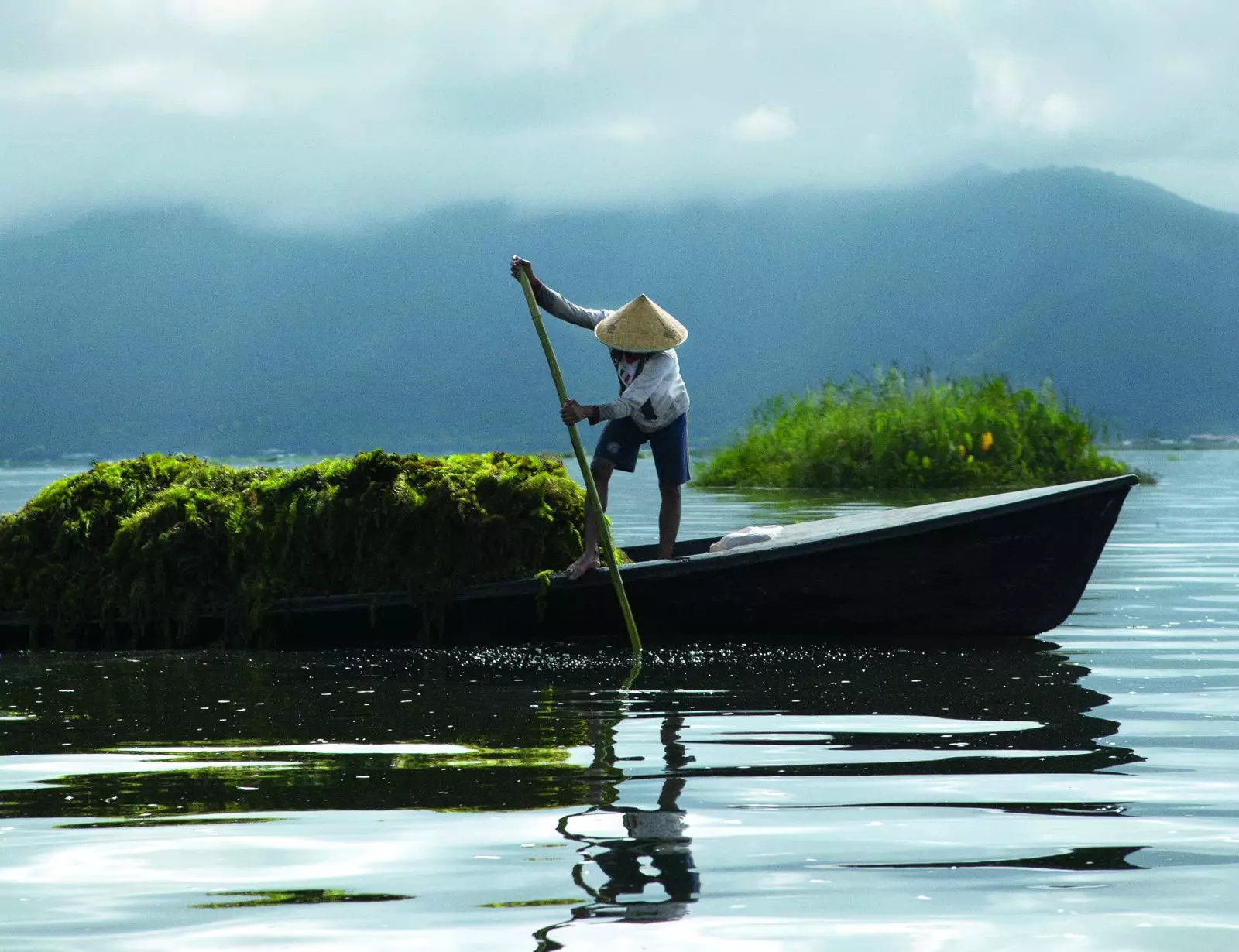
Inle Lake fisherman at the beginning of his ancestral dance.
The colors of the Myanmar flag are not an anecdote in history , but the mantle that flows and shapes its anatomy. Three colored stripes – red, green and yellow – and a white star in the middle. It is the inert lime that rises among the toy temples of Mingun , and that vermilion of the spicy pods that intoxicates when crossing Inle floating gardens . It is the moist greenery that forms between the opium fields laid out by Shan soldiers during the Anglo-Burmese war, and the hot sphere that hides every sunset by the pagodas of Bagan.
A chromatic trail that guides you when traveling this vast territory in Southeast Asia , where time seems to have stopped as if it were still entangled in the British brawls of Daniel Manson's novel, The Piano Tuner. In her, when it still bore the name Burma , the arduous journeys during the dry season were made on the back of an elephant and the nights were spent between endless pwés, street theaters and puppet games who interpreted the legends of their ancestors by candlelight.
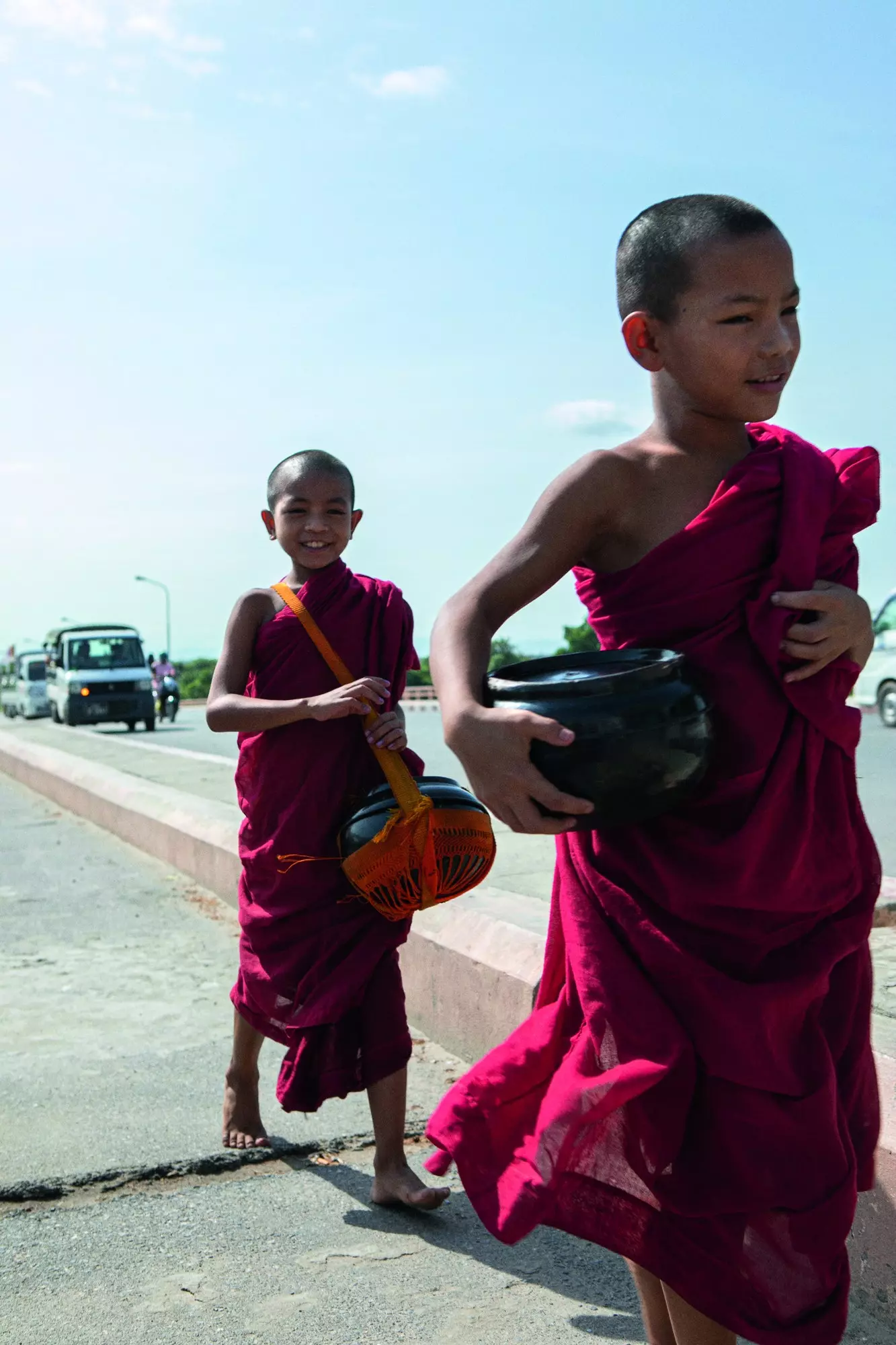
Novice monks scampering towards Soon OoPon Nya Shin pagoda.
If the western figure of that time was limited to the British colonial army and the troops of French soldiers and scientists fascinated by its singular botany, we can say that the globalization that emanates from an incipient tourism has not yet made a dent . A military dictatorship that did not end until 2011 meant that the Republic of Myanmar remained a virgin to foreign contact, despite being one of the most coveted territories on the continent.
The fertile opium crop and a strategic position bordering India, Bangladesh, Thailand, Laos, China to the north and the Bay of Bengal to the south, have been the subject of continuous wars for their dominance. This, together with its wealth of jades and oil , by which the British Empire remained tight to the territory until its independence in 1948.
The following decades plunged the country into a continuous evolution of civil conflicts, changes of administrative capital and military coups until its opening to the new democracy. Along the way, the struggle for the autonomy of its numerous ethnic groups so as not to numb their culture and economy has given rise to a melting pot of languages fostered by the mountain formations and the scarce coming and going of English between their populations.
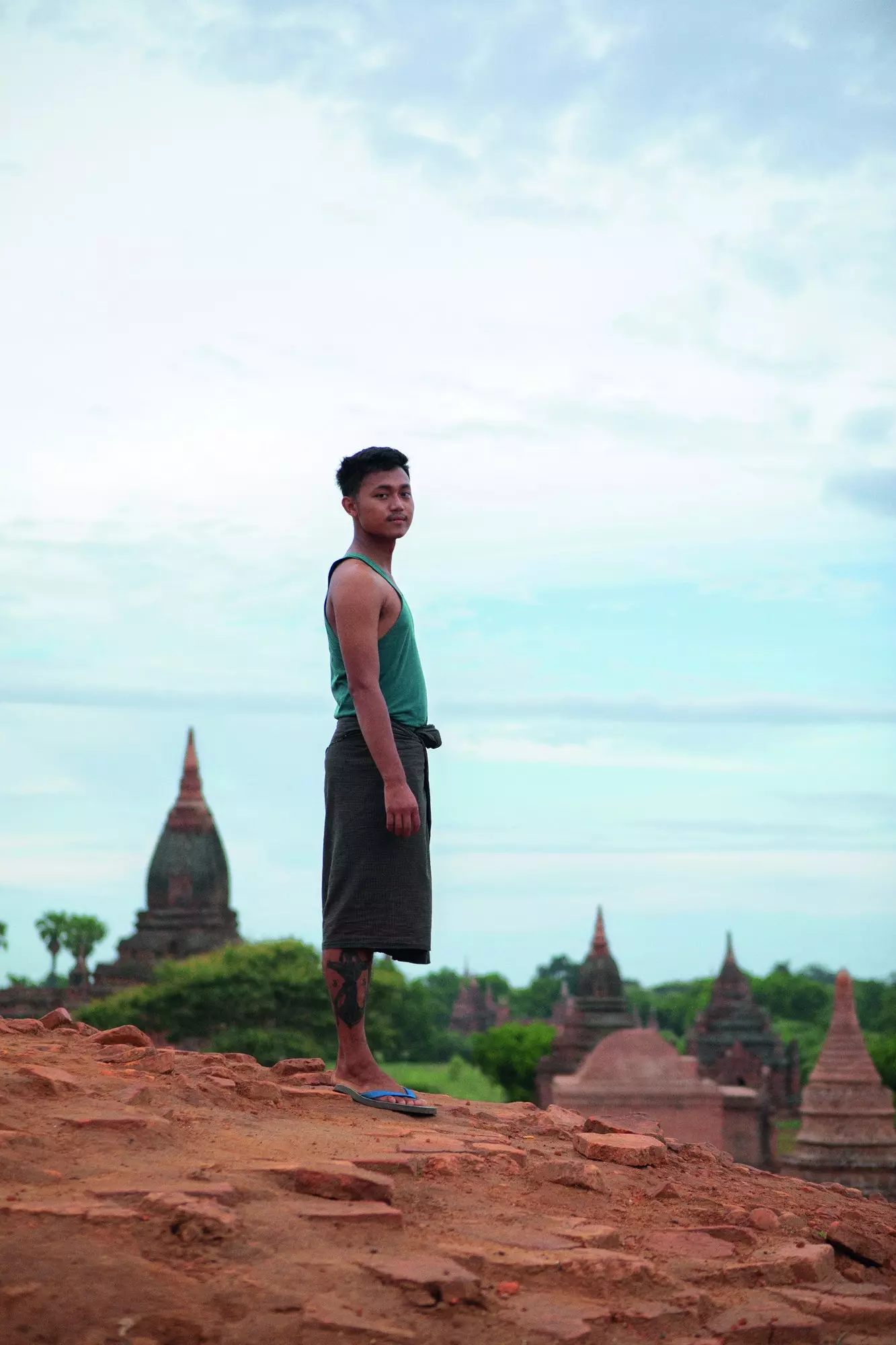
A Bagan from above.
Mingala ba, the popular Burmese greeting that unites all ethnic groups , accompanies us from our arrival in mandalay . The suffocating heat that reigns in this former royal capital is mixed with the horn of the colorful tuk–tuks that circulate on the street. That chaotically harmonious traffic that characterizes Asian cities welcomes us along with the smiling faces painted with thanaka, a light, yellow cream made by grinding the bark of the tree of the same name and that daily blurs gender among its inhabitants.
The first rays of the sun form the perfect setting for visit the Mahamuni pagoda, south of the city . Thousands of parishioners head towards her, since its creation in 1785 , to observe how the body of the most famous Buddha in the country is washed and perfumed with rose water. Such is their devotion that the towels applied to dry it with great care are later given to visitors. This sculpture of Gautama Buddha, covered in gold in its almost four meters high , is one of the oldest representations known since its creation.
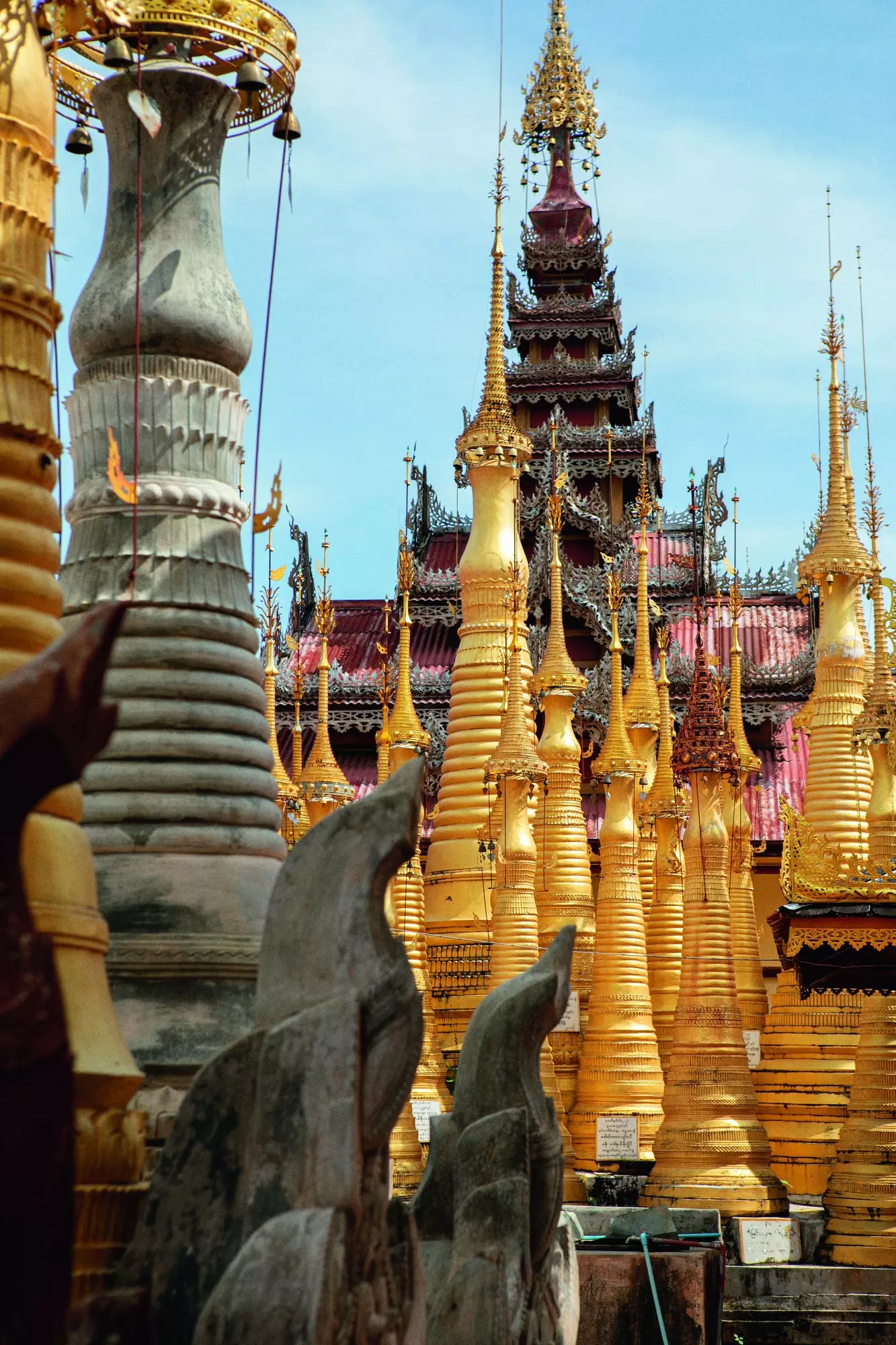
More than a thousand stupas wind through the glorious Shwe Inn Thein Paya.
But this is not the only record held by the region. Not far from here stands the Kuthodaw pagoda, whose 729 white stupas guard as if they were the Warriors of Xian the pages of the Tripitaka, the largest book in the world . Each of them registered in gold ink on a marble headstone They were looted by the British in 1885.
Its precise design, only perceptible from the sky, shows the attachment to geometric construction in temples and monasteries , as well as at the top of Mandalay Hill. On this hill, according to legend, Buddha predicted the creation of the city.
Climb the 1,729 steps leading to Taung Pyamerecen pagoda they will be worth it –also accessible by elevator– if you are looking for the best panoramic view of the city, dotted with temples among its canals and endless flower meadows, as a sample the Lwin Flower festival every December.
This conception of space as if it were a chessboard seems greedy and almost postmodernist in Sagain, one of the four royal cities surrounding Mandalay . The former capital of the country between 1760 and 1764 has an incalculable network of monasteries, and was for a long time the place of pilgrimage for monks seeking to instruct themselves in the teachings of Buddhism.
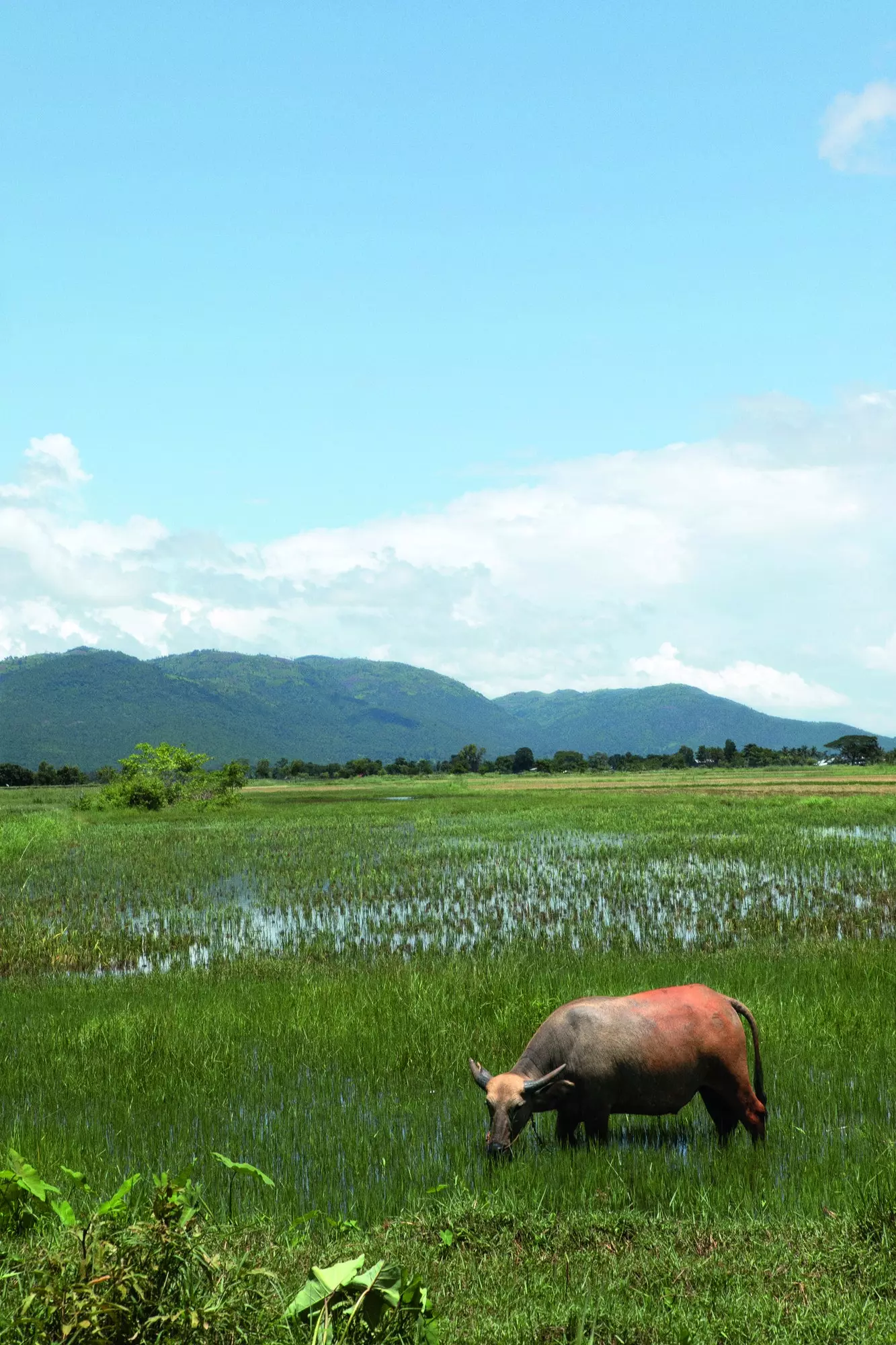
Water buffalo guard the Kalaw grasslands.
We take off our shoes and cover our legs with a longyi, an almost mechanical gesture at the entrance of any monastery, to follow the path of the pink, mint green and baby blue tiles that they take us to the pagoda Soon Oo Pon Nya Shin . An almost 'religious' experience that will culminate at the U Min Tounzeh temple , whose circular gallery formed by impassive Buddhas among emeralds stuns us with its gleaming gold leaf and fresh flowers on the altars.
To calm the midday heat, nothing better than resorting to a rattan hat and a lime tea that they will offer you on the slopes of the hill, before heading to Mingun in a buggy that seems to jump into the air at every bump. Already on the shore of the riverbank, bamboo rafts wander both directions of the Ayeyarwady River . We take one of the boats to reach this ancient royal capital, where semi-ruined pagodas and the second largest bell in the world await us.
In the distance we can see the Hsinbyume temple , a snowy speck in honor of its name, White Elephant, among the thick brick jungle that surrounds it. Its concentric shape was inspired on the terraces of the mythical mount Meru , and was erected in memory of Princess Hsinbyume, who died giving birth to her firstborn. In front of the riverbank they await us unperturbed the inwa ruins . The splendor of this royal metropolis only remains in the memory due to the earthquake of 1839.
However, that neglected beauty that emanates from archaeological disasters makes you feel in the shoes of a nineteenth-century explorer when you walk through its skeleton of brick, ash and snaking moss. A similar sensation is manifested when feeling the creak of the teak over the U Bein bridge.
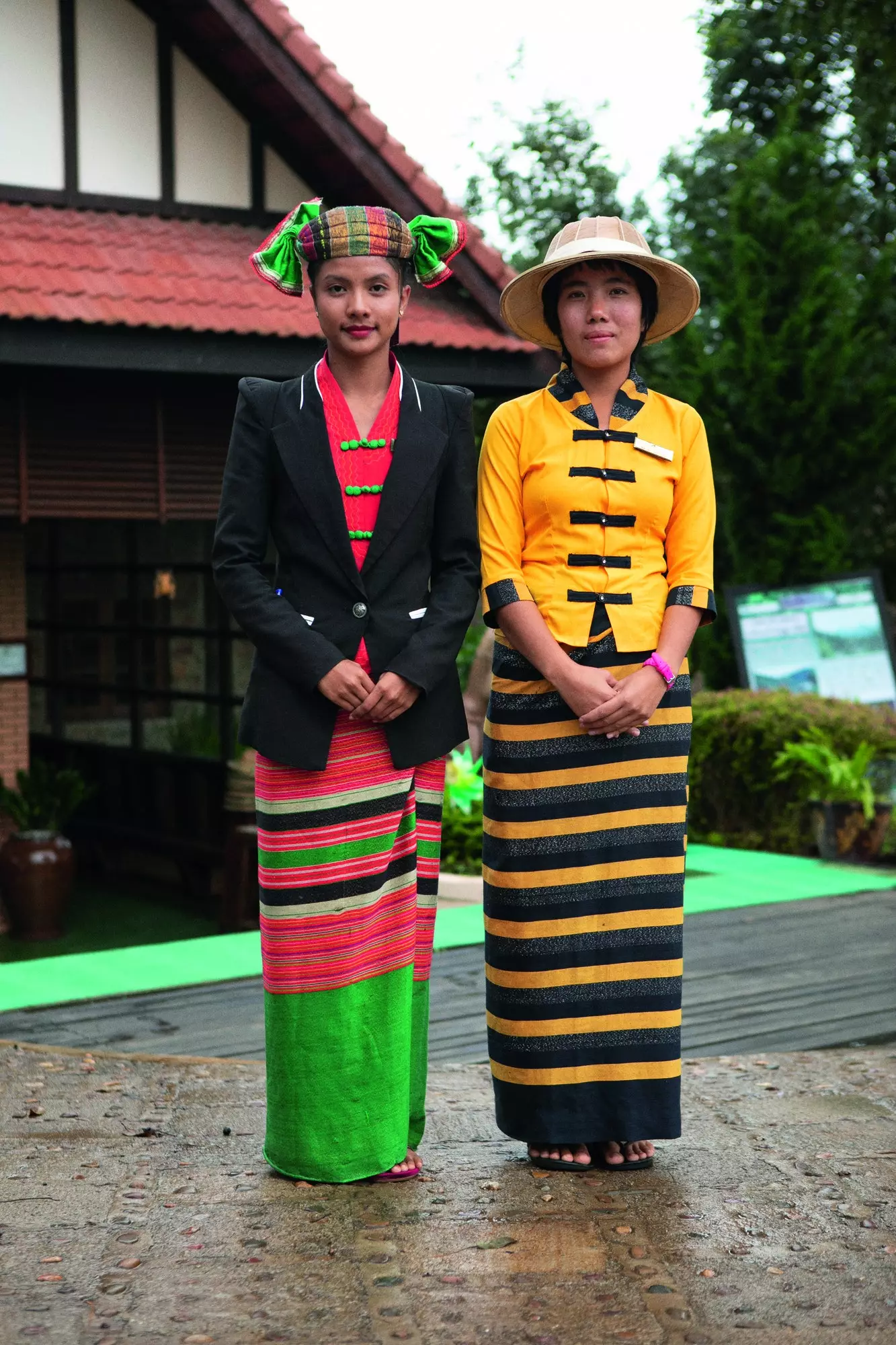
Sample of the textile folklore that embraces the Kalaw uniforms.
This 1851 construction is the biggest tourist attraction in Amarapura, the fourth and last imperial city we visited in Mandalay . Taking the required selfie without people around you is an impossible task, since the 1.2 kilometers of the longest teak bridge in the world are packed.
THE CITY OF 2,000 TEMPLES
"The mountains of Shan rose out of the plain, beyond the temples that stood like soldiers in formation, and seemed suspended in the sky." The first sunset on our arrival in Bagan is so overwhelming like the one narrated by the protagonist of Daniel Manson's novel. It is hard to imagine that the majestic Mandalay is only four hours away by road, eight if you decide to cover the 145 km that separate both cities by crossing the Ayeyarwady River by boat.
World Heritage since 2019, Bagan concentrates the largest number of tourist visits in the region . That freedom with which the military climbed their pagodas during the Victorian era is just an anecdote of exchange between the guides, although it is still allowed to climb some ruins to see the most emblematic image of the country.
The one where Myanmar and Burma seem to mean the same thing , dissipating the history and the political ups and downs between the 2,000 temples that are still standing , almost a fifth of those that were built in the region during the s. XII. The list is endless: Thatbyinnyu, known as the 'Omniscient' , the tallest in all of old Bagan with its cross plan and the many frescoes on its domes; Gubyaukgyi, exotic and disciple of the Indian Shikhara style , with banyan leaves and swastikas; Gaw Daw Palin Phaya, which mystically lights up at sunset…
To discover old Bagan as your ancestors traced it, nothing better than rent a bike, do without plans and hit the shortcuts that link the villages. You might stumble across the village of Pwa Swa, recognizable for its looms and cotton fields, or cross the sesame plantations that are home to Minnanthu. And, if tiredness still does not make an appearance, you can cycle to Zee village and look at one of the tamarind trees oldest in the world. They say that the nats stay here, spirits that protect the locals from their sacred forest.
A few kilometers away, in the new Bagan, the legends dissipate and the pace picks up when life goes on between backpackers, food stalls and buggies who walk with a military pulse. At the other end of town, in Nyaung-U, the proposal of the mediatic Mr. Sharky rises , as Ye Htut Win, a judge on the Burmese edition of Masterchef, is popularly known.
Coming from a family of diplomats, he decided to transfer his globetrotting life to the kitchen after making his fortune in Switzerland running several cocktail bars. Sharky's, as Win explains, is a Bagan and Yangon-based restaurant chain that was born to strengthen the local gastronomy, renewed with modern techniques acquired during his long journey around the world.
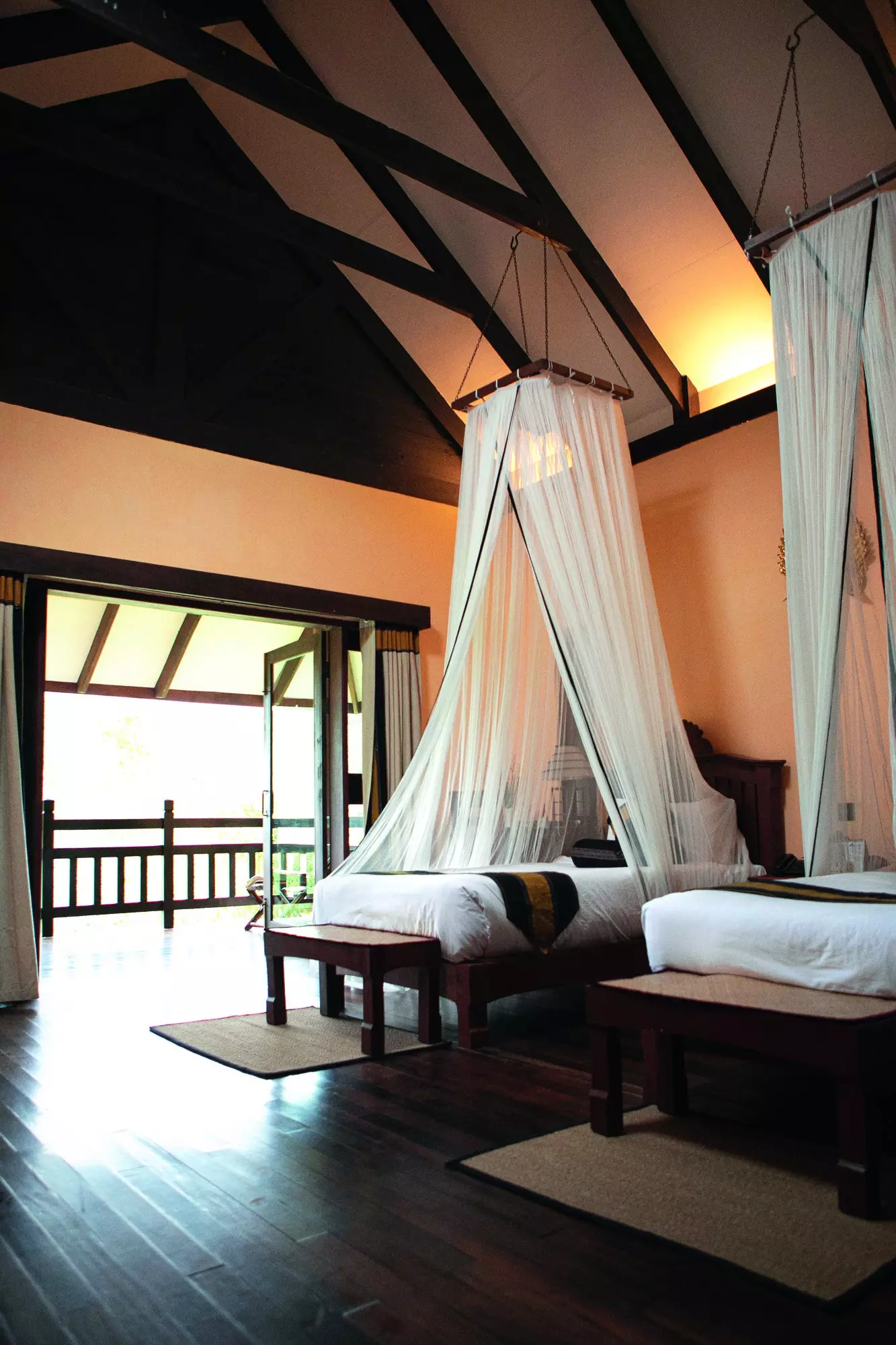
Austere luxury in the rooms of the Kalaw Hill hotel.
The packaging is what you would expect: an old theater converted into a hipster bar where wooden benches, Vichy tablecloths and glass jars in the form of lamps follow one another. Contained modernity where you can try curious sandwiches, gluten-free salads and one of its star dishes, the ravioli with ricotta and pumpkin . Its Chilean wines are well worth a drink, and will be a good pick-me-up before heading to the next destination.
In just five hours of travel by road we will arrive to the heart of the Shan mountains to reach the city of Kalaw, a place of pleasant passage where to rest before undertaking the busiest trekking route in Myanmar. The hustle and bustle of the local merchants contrasts with the calm of the resorts at its peak, more than 1,500 meters above sea level.
Its Catholic Church of Christ the King, Famous for having the same priest for seven decades, it seems to invite us to have a cup of tea from its white brick facade. Fruit of British colonization, it was also the settlement of a community of Muslim Indians and their masjid, their mosque , painted in mint water from the 1950s. This peaceful coexistence between cults seems oblivious to the tensions of the Rohingya Muslim minority in the north of the country.
Cross the paddy fields, tea fields and mountain slopes that separate Kalaw from Inle Lake It requires patience, good footwear and a firm smile on your face. Especially if we undertake it in the rainy season, when the mud is another travel companion. Little by little we will blend in with the terracotta curtain that forms in our path and that exerts of the immense contrast with the chlorophyll fields.
Traversing the path that guides local farmers on foot involves running into majestic water buffalo carrying the harvest and spend the night in the villages. As in other regions of the country, the mountains not only act as a geographical divider, but also preserve the customs of each community. Yes indeed, the use of 4G technology, motorcycle rides and a passion for football They unify the landscape wherever you go.
After long days of walking you will be able to see the villages of Pe Tu Pork, Paw Ke or Khone Hla and the routine of the few families that support them. The West is far away in memory; no electricity or hot showers , relaxing means enjoying a simple dinner of rice and tea leaves before falling asleep in the common bedrooms offered by the family houses.
An ideal time to converse with the Danu and Pao-O , the dominant ethnic groups of the region that overshadow by their clothing and headdresses. Already in the last section of descent, the tropical heat overwhelms us before taking a boat between torrents of orange water to reach Inle Lake.
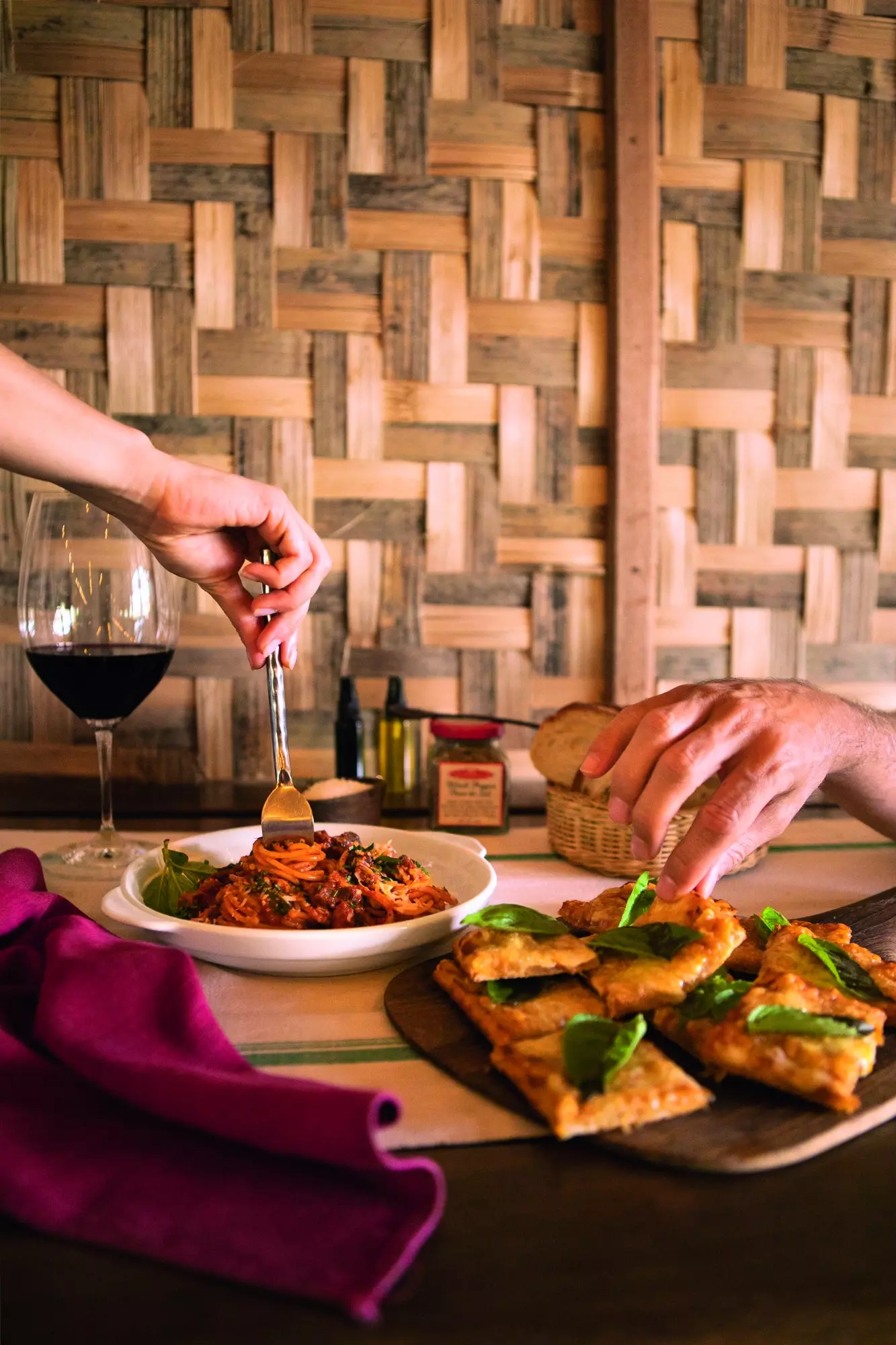
Al dente dishes with a certain local aftertaste on the Sharky's menu.
A mantle of floating cities has been woven over the ecosystem of this mass of 12,000 ha of fresh water guarded by the Shan mountains. humble metal and bamboo constructions, Nyaung Swe being the most populous . A primitive Venice where the vaporettos are replaced by boats that protect the fishermen with their ancestral one-legged dance.
Here agriculture also fantasizes about its own code: multitude of gardens and orchards in the water supply the community between the noise of the oars. Temples are also not in short supply; worth a visit Phaung Daw Oo Pagoda to be blinded by the gold leaf with which the gods are rubbed . As in many other holy places, women are not allowed to participate.
The cigars that are pressed in the village of Nampan and the looms of In Phaw Khone compete for the interest of the tourist. Authenticity is concentrated at Taunggyi market in Ywana , a reliable image of the racket narrated by Manson. Among puddles we get lost in their aforementioned trays of betel nuts and linden branches ; knife sharpeners, sellers of false teeth and religious icons; sandals, mirrors, dried fish and crab, rice , steps, umbrellas...
Appliances and food that show the customs of the intha tribe . We watch them get their hair cut at a street stall or chew endlessly kun ja balls of tobacco… Only a tour of decadent Inthein can shock as much as this sociological portrait. A tumult of centuries-old pagodas will come to meet you so that you feel like Lara Croft for a moment.
The half-ruined landscape of lime, brick and verdigris of Nyaung Ohak watched over by devas and chinthe, the mythological animals carved in stucco, will lead us to the glorious Shwe Inn Thein Paya, with over a thousand stupas weather-beaten. The time has come to say goodbye to the lake from the slate pool of the Sanctum Inle, an old monastery converted into a luxury hotel where body and mind are rewarded.
The colonial face of Yangon, the largest city in the country , is dotted with pagodas and skyscrapers. It is an obligatory step to reach the coastal cities of the Bay of Bengal. There stands Ngwe Saung, whose short existence – it was founded in 2000 – means that tourist exploitation is not yet notorious. Fifteen kilometers of beach remain almost intact between forests and resorts under construction, small hostels and abandoned villas.
There are hardly any souvenir shops or massage centers. The palate, however, will not suffer upon arrival at Tazin, the nearby fishing village where you can try fresh seafood and shout at the top of their lungs in their KTV's some Bonnie Tyler hit. The thanaka faces that run these karaokes will put the finishing touch to a journey that does not end here.
The memory of Myanmar grows after the game , like the rumor of an old world that drags us to a previous life, full of rites and in which time moves slowly.
*This report was published in the number 139 of the Condé Nast Traveler Magazine. Subscribe to the printed edition (11 printed issues and a digital version for €24.75, by calling 902 53 55 57 or from our website). The issue of Condé Nast Traveler for May and June is available in ** its digital version to enjoy it on your preferred device. **
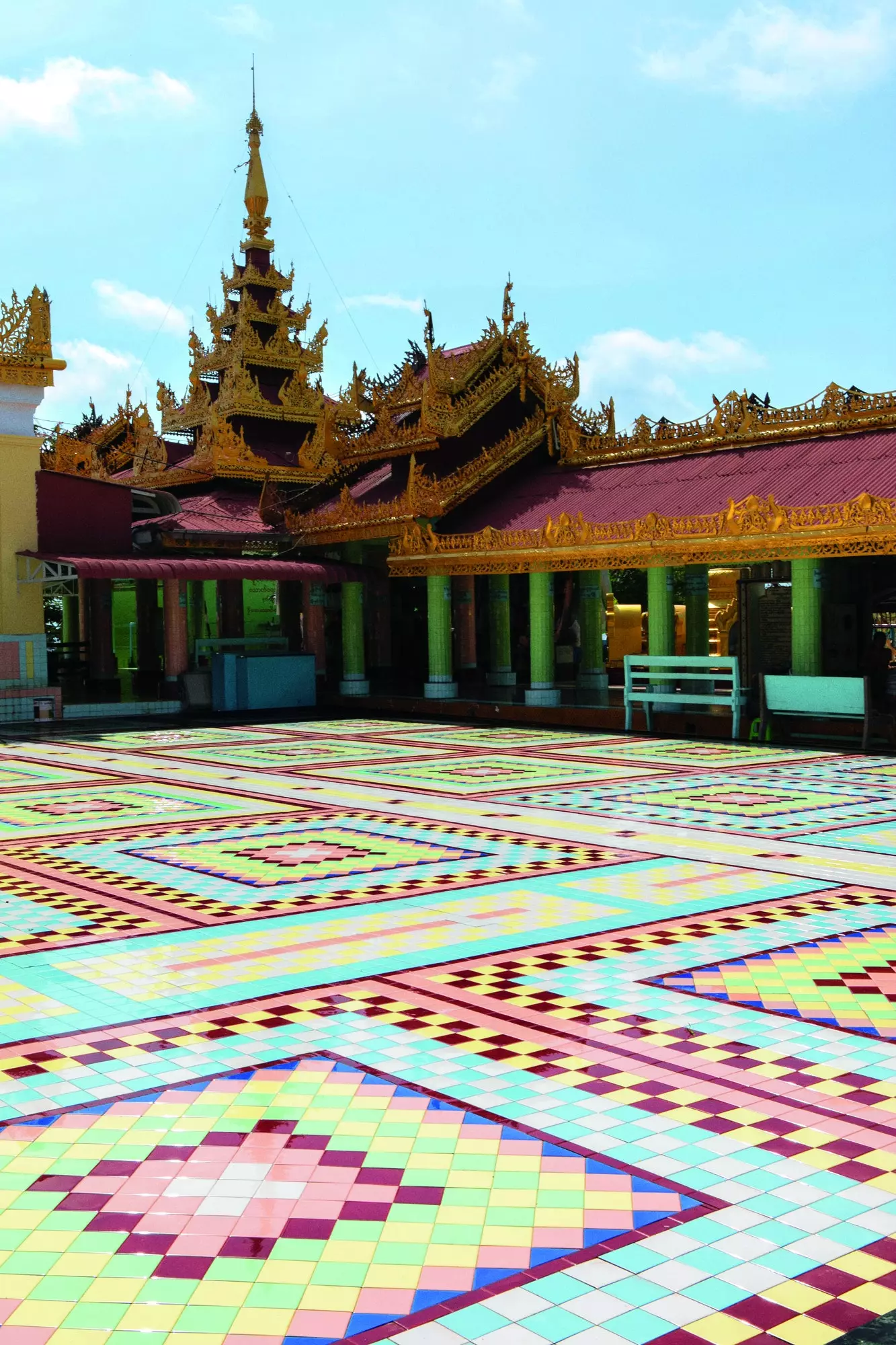
Follow the path of pastel tiles at Soon Oo Pon Nya Shin pagoda.
